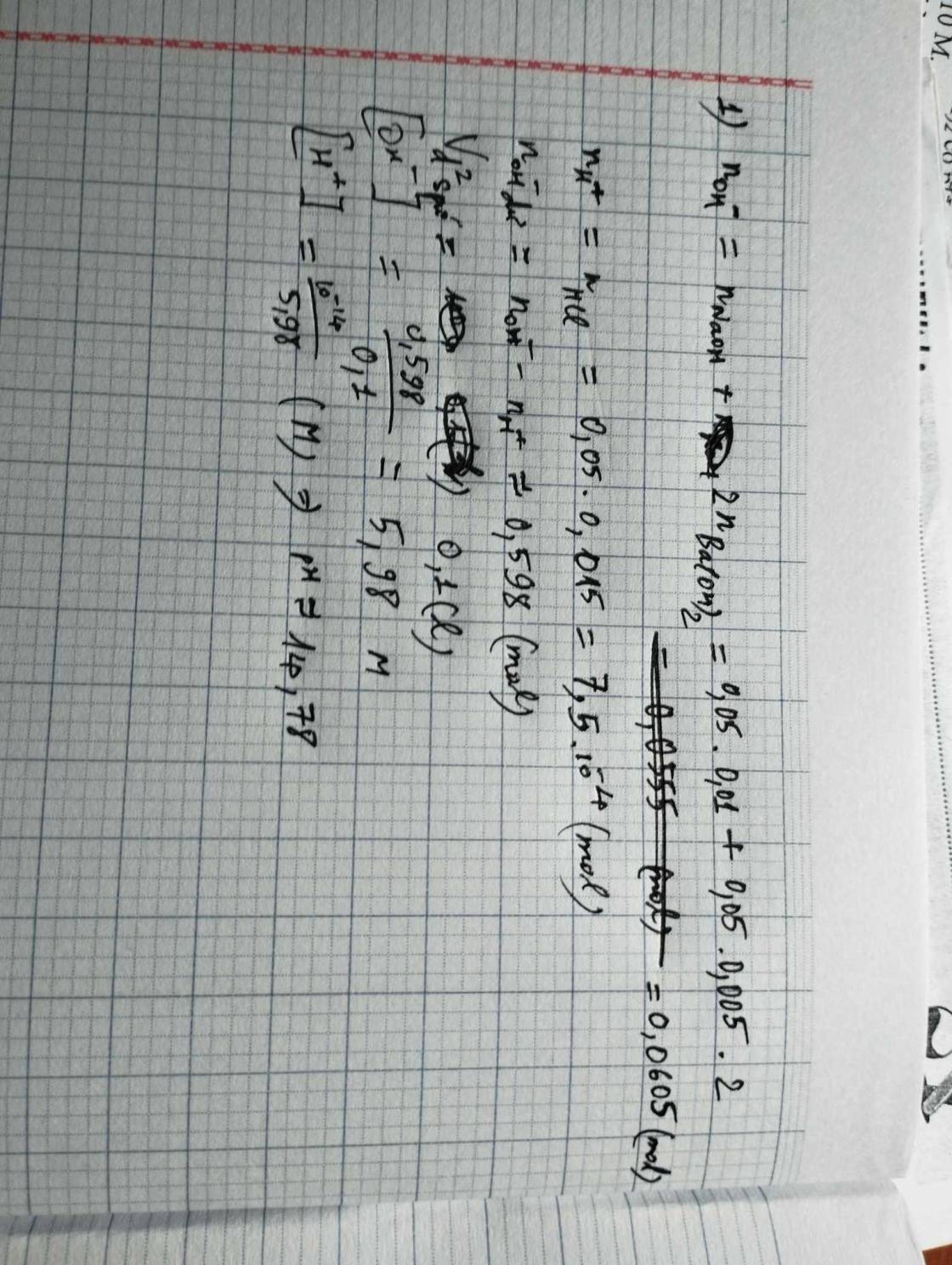Hãy nhập câu hỏi của bạn vào đây, nếu là tài khoản VIP, bạn sẽ được ưu tiên trả lời.

Quy tắc đường chéo:
Cùng bản chất thì trừ nhau, khác bản chất thì cộng lại.\(\begin{matrix}\left[H^+\right]=1\left(M\right)\\\left[OH^-\right]=x\left(M\right)\end{matrix}\left[H^+\right]=0,1\left(M\right)\dfrac{x+0,1}{1-0,1}=\dfrac{V_{H^+}}{V_{OH^-}}=\dfrac{600}{400}\Rightarrow x=1,25\left(M\right)\)

2) Đặt số mol Na2CO3 là x mol, số mol NaHCO3 là y mol
nHCl=0,9.0,5=0,45(mol)
nH2=0,3(mol)
Ta có PTHH
---------------Na2CO3 + 2HCl ----> 2NaCl + H2O + CO2
mol-------------x-------------2x------...
---------------NaHCO3 + HCl -----> NaCl + H2O + CO2
mol------------y--------------y-------...
Ta thấy HCl dư do 0,45>0,3
tự tính độ pH nha
3) Ta có công thức:
C%=CM*M(HCOOH)/10*d
=>CM(đầu)=C%*10*d/M(HCOOH)
=0.46*10*1/46=0.1(mol/l)
_Dung dịch sau phản ứng có pH=3:
=>CM(H+)=10^-3(mol/l)
HCOOH<=>H{+}+HCOO{-}
10^-3------->10^-3(mol/l)
=>CM(HCOOH sau)=10^-3(mol/l)
_Độ điện li alpha=CM(HCOOH sau)/CM(đầu)
=10^-3/0.1=0.01=1%
=> chọn C

dd Hcl 1M => [H+]=1M
dd h2so4 1M =[H+]=1M
==> tổng [H+]= 2M
vs dd bazơ làm tương tự nha!
b) nH+ ban đầu= 2* 0,1= 0,2mol
nOH- bđ=1,5* 0,3=0,45mol
==> nOH- dư=0,25mol
==>[OH-] dư= 0,25 : 0,4= 0,625M==> pH=14+log(0,625) ok!
kết tủa là baso4 bạn dùng số mol chất hết để tính m nha!

Bài 1:
Ta có: \(\Sigma n_{OH^-}=n_{NaOH}+2n_{Ba\left(OH\right)_2}=0,05.0,01+0,05.0,005.2=0,001\left(mol\right)\)
\(n_{H^+}=n_{HCl}=0,05.0,015=0,00075\left(mol\right)\)
PT ion: \(OH^-+H^+\rightarrow H_2O\)
______0,001__0,00075 (mol)
⇒ OH- dư. nOH- (dư) = 2,5.10-4 (mol)
\(\Rightarrow\left[OH^-\right]=\frac{2,5.10^{-4}}{0,1}=2,5.10^{-3}M\Rightarrow\left[H^+\right]=4.10^{-12}M\)
\(\Rightarrow pH\approx11,4\)
Bài 2: Đáp án D
Giải:
Ta có: \(\Sigma n_{H^+}=n_{HCl}+2n_{H_2SO_4}=0,1.0,002+0,2.2.x=2.10^{-4}+0,4x\left(mol\right)\)
\(\Rightarrow\left[H^+\right]=\frac{2.10^{-4}+0,4x}{0,3}M\)
\(\Rightarrow pH=-log\left(\frac{2.10^{-4}+0,4x}{0,3}\right)=2,7\)
\(\Rightarrow x\approx9,964.10^{-4}\approx10^{-3}\)
Bạn tham khảo nhé!

a) NH3 + HCl --> NH4Cl (1)
nNH3=0,005 (mol) , nHCl = 0,0025 (mol)
Theo pt (1) ta thấy dd A gồm : 0,0025 mol NH3 dư (0,25M)
0,0025 mol NH4Cl (0,25M)
NH4Cl --> NH4+ + Cl-
0,25 --> 0,25
NH3 + H2O <---> NH4+ + OH-
bđ 0,25 0,25
pli x --> x ---> x
cb (0,25 - x) (0,25 +x) x
=> \(\frac{\left[NH4^+\right].\left[OH^-\right]}{\left[NH3\right]}\) = pKb =4,75= \(\frac{\left(0,25+x\right).x}{0,25-x}\)
=> x= 0,227
=> pOH=-log[OH- ] = -log[x] = 0,644
=> pH=14 - pOH= 13,356
b) nHCl (thêm vào ) = 0,001(mol)
Theo (1) ta có sau khi thêm 0,001 mol HCl vào 1l dd A thì dd sau pư gồm :
+ nNH3 (dư) = 0,025 - 0,001 = 0,024 (mol) (0,024M)
+ nNH4Cl =0,025 + 0,001 =0,026 (mol) ( 0,026 M)
NH4Cl --> NH4+ + Cl-
0,026 ---> 0,026
NH3 + H2O <--> NH4+ + OH-
bđ 0,024 0,026
pli y ---> y ---> y
cb (0,024 - y) (0,026 +y) y
=> pKb=4,75=\(\frac{\left(0,026+y\right).y}{0,024-y}\) => y=0,02375
=> pOH=-log(0,02375)=1,624
=> pH=14 - pOH=12,376

B
nHCl=0,6
nNaOH=0,5
=>nHCl dư =0,1(mol)
nH+=0,1(mol)=1.10-1
=> PH=1